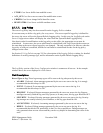Execute Hostname. This is the hostname of the node on which the server will execute. It must match the
Execute Hostname of the Startup Daemon that is to manage this server. For most servers, setting this
field is straightforward, but for remote Movers, this indicates the node on which the Mover
administrative interface process runs (not the node where the remote Mover process runs). Note that if
the Execute Hostname is changed, it is likely that the RPC program number will change as well. If the
server affected is the System Manager, the SSM configuration file, ssm.conf, must be regenerated or
edited.
Program Number. The RPC program number. This value must be unique within the node in which the
server runs. The administrator cannot override the default program number value when creating or
modifying a server configuration.
Version Number. The RPC version number. The administrator can not override the default version
number value when creating or modifying a server configuration.
UNIX Username. The UNIX user name under which the server will run. The name must be registered in
the local UNIX authentication database (e.g., /etc/passwd) or the HPSS local password file. The Startup
Daemon will use this user ID when starting the server. If there is no such user, the Startup Daemon will
not be able to start the server.
Minimum Database Connections. This field is no longer used and will be deleted in a future version of
HPSS. Database connections are managed dynamically and the number of database connections a server
uses is based on the activity of the server. Some servers use the database only when they start and never
again. Database connections used by such servers are eventually closed so that the server uses no
connections at all. If the server should need a connection at some later time, one will be created.
Creating database connections is a fairly low overhead activity, while maintaining unused connections is
a relatively high overhead activity, so the system tries to keep unused connections at a minimum.
Maximum Database Connections. The meaning of this field has changed in HPSS 7.1. Servers are
allocated database connections dynamically, using as many as are needed to perform the work at hand.
Servers will create additional database connections up to Maximum Database Connections without
delay, on demand. Once this number of connections exist, requests for additional connections will be
delayed for a short period of time to give the server a chance to reuse an existing connection. If an
existing connection does not become available within this time limit, a new connection will be created
and processing will resume. The server's internal value for Maximum Database Connections is
adjusted up to this new value to reflect the larger dynamic workload.
As described above, if the workload subsides, unused database connections will eventually be closed and
the server will run with the number of connections that is appropriate to the workload.
Since this setting is actually dynamic, it may be removed in a future version of HPSS.
Auto Restart Count. Maximum number of automatic restarts allowed per hour. See Section 5.2.2.4:
Automatic Server Restart on page 151 for more details.
Executable. A flag that indicates whether an HPSS server can be executed by SSM.
Auto Startup. A flag that indicates whether SSM should attempt to start the server upon startup of SSM.
The Startup Daemon must be started before SSM for this option to work.
HPSS Management Guide November 2009
Release 7.3 (Revision 1.0) 91


















